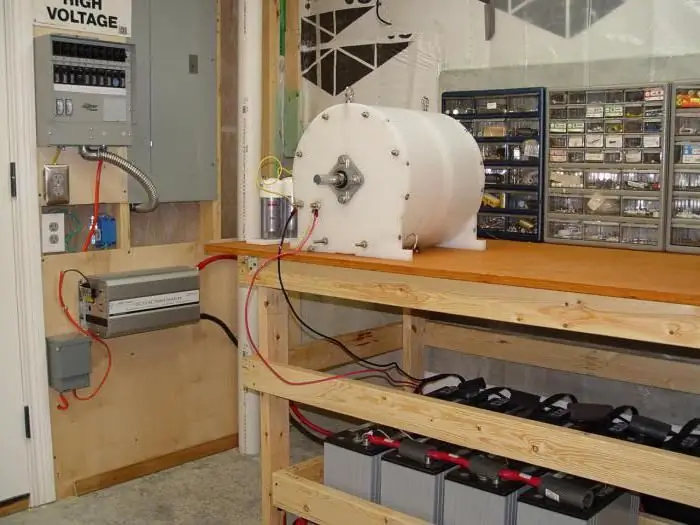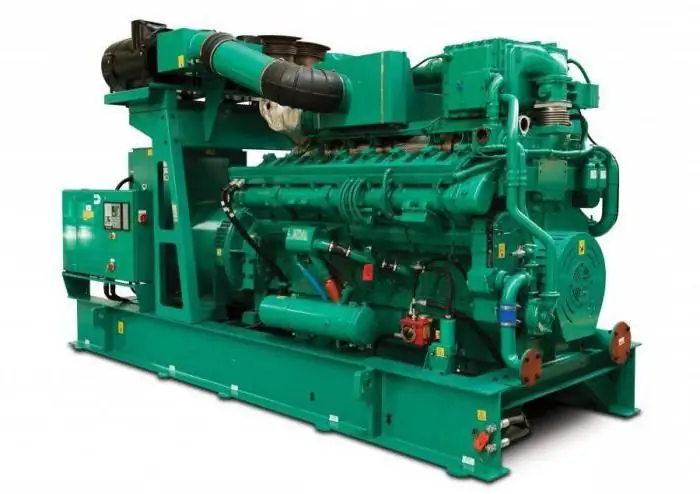2026 Author: Howard Calhoun | [email protected]. Last modified: 2025-01-24 13:10:33
The current-limiting reactor is a coil with a stable inductive resistance. The device is connected in series in the circuit. As a rule, such devices do not have ferrimagnetic cores. A voltage drop of about 3-4% is considered standard. If a short circuit occurs, the main voltage is applied to the current-limiting reactor. The maximum allowable value is calculated by the formula:
In=(2, 54 Ih/Xp) x100%, where Ih is the rated line current and Xp is the reactance.

Concrete structures
The electrical apparatus is a design that is designed for long-term operation in networks with voltages up to 35 kV. The winding is made of flexible wires that dampen dynamic and thermal loads through several parallel circuits. They allow you to evenly distribute currents, while unloading the mechanical force on a stationary concrete base.
The mode of switching on the phase coils is chosen so that the opposite direction of the magnetic fields is obtained. This also contributes to the weakening of dynamic forces at shock short-circuit currents. Open placement of windings in space contributes toproviding excellent conditions for natural atmospheric cooling. If the thermal effects exceed the allowable parameters, or a short circuit occurs, forced airflow is applied using fans.

Dry Current Limiting Reactors
These devices are the result of the development of innovative insulating materials based on a structural basis of silicon and organics. The units successfully operate on equipment up to 220 kV. The winding on the coil is wound with a multi-core cable with a rectangular cross section. It has increased strength and is covered with a special layer of organosilicon paintwork. An additional operational plus is the presence of silicone insulation containing silicon.
Compared to concrete counterparts, the dry-type current-limiting reactor has a number of advantages, namely:
- Lighter weight and overall dimensions.
- Increased mechanical strength.
- Increased temperature resistance.
- More supply of working resource.

Oil options
This electrical equipment is equipped with conductors with insulating cable paper. It is mounted on special cylinders that are in a reservoir with oil or a similar dielectric. The last element also plays the role of a heat dissipation part.
To normalize the heating of the metal case, the design includes magnetic shunts or screens onelectromagnets. They allow you to balance the power frequency fields passing through the turns of the winding.
Magnetic type shunts are made of steel sheets placed in the middle of the oil tank, right next to the walls. As a result, an internal magnetic circuit is formed, which closes the flux created by the winding.
Electromagnetic type screens are made in the form of short-circuited coils of aluminum or copper. They are installed near the walls of the container. They induce an oncoming electromagnetic field, which reduces the impact of the main flow.
Models with armor
This electrical equipment is created with a core. Such designs require an accurate calculation of all parameters, which is associated with the possibility of saturation of the magnetic wire. Careful analysis of operating conditions is also required.

Armored cores made of electrical steel make it possible to reduce the overall dimensions and weight of the reactor along with a reduction in the cost of the device. It is worth noting that when using such devices, one important point must be taken into account: the shock current should not exceed the maximum allowable value for this type of device.
The principle of operation of current-limiting reactors
The design is based on a coil winding with inductive resistance. It is included in the break of the main supply chain. The characteristics of this element are selected in such a way that under standard operating conditionsthe voltage did not drop above 4% of the total.
If an emergency situation occurs in the protective circuit, the current-limiting reactor, due to the inductance, extinguishes the predominant part of the applied high-voltage action, while simultaneously containing the surge current.
The scheme of operation of the device proves the fact that with an increase in the inductance of the coil, a decrease in the impact of the shock current is observed.

Features
The electrical apparatus under consideration is equipped with windings that have a magnetic wire made of steel plates, which serves to increase reactive properties. In such units, in the case of the passage of large currents through the turns, saturation of the core material is observed, and this leads to a decrease in its current-limiting parameters. Consequently, such devices are not widely used.
Mostly current-limiting reactors are not equipped with steel cores. This is due to the fact that the achievement of the required inductance characteristics is accompanied by a significant increase in the mass and dimensions of the fixture.
Surge short-circuit current: what is it?
Why do we need a current-limiting reactor of 10 kV or more? The fact is that in the nominal mode, the supply high-voltage energy is spent on overcoming the maximum resistance of the active electrical circuit. It, in turn, consists of an active and reactive load, which has capacitive and inductive couplings. As a result, an operating current is generated, which is optimized using impedancecircuit, power and voltage indicator.
When a short circuit occurs, the source is shunted by randomly connecting the maximum load in combination with the minimum active resistance, which is typical for metals. In this case, the absence of the reactive component of the phase is observed. A short circuit levels the balance in the working circuit, forming new types of currents. The transition from one mode to another does not occur instantly, but in a protracted mode.

During this momentary transformation, the sinusoidal and overall values change. After a short circuit, new current forms can acquire a forced periodic or free aperiodic complex form.
The first option contributes to repeating the configuration of the supply voltage, and the second model involves the transformation of the indicator in jumps with a gradual decrease. It is formed by means of a capacitive load of the nominal value, considered as an idle for a subsequent short circuit.
Recommended:
Bank accounts: current and current account. What is the difference between a checking account and a current account

There are different types of accounts. Some are designed for companies and are not suitable for personal use. Others, on the contrary, are suitable only for shopping. With some knowledge, the type of account can be easily determined by its number. This article will discuss this and other properties of bank accounts
Classification of engines. Types of engines, their purpose, device and principle of operation

Nowadays, most vehicles are powered by an engine. The classification of this device is huge and includes a large number of different types of engines
Electric motor with gearbox: features, device and principle of operation

Nowadays, it is difficult to find an industry that does not use geared motors. This unit is a kind of electromechanical independent unit in which the electric motor and gearbox work in pairs
Electric locomotive 2ES6: history of creation, description with photo, main characteristics, principle of operation, features of operation and repair

Today, communication between different cities, passenger transportation, delivery of goods is carried out in a variety of ways. One of these ways was the railroad. Electric locomotive 2ES6 is one of the types of transport that is currently actively used
Gas piston power plant: the principle of operation. Operation and maintenance of gas piston power plants

Gas piston power plant is used as a main or backup source of energy. The device requires access to any type of combustible gas to operate. Many GPES models can additionally generate heat for heating and cold for ventilation systems, warehouses, industrial facilities

